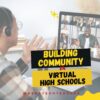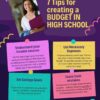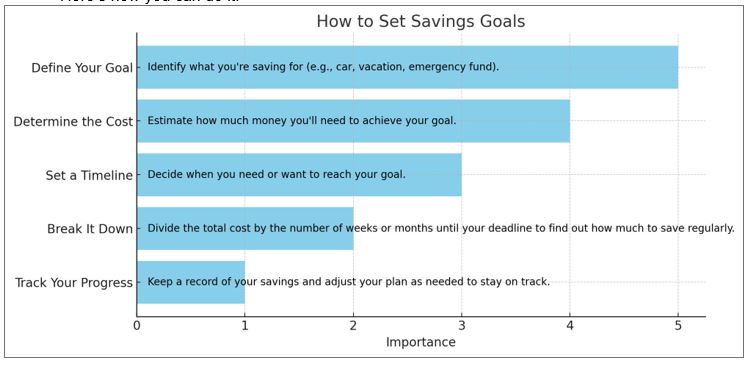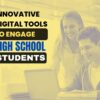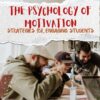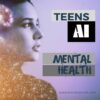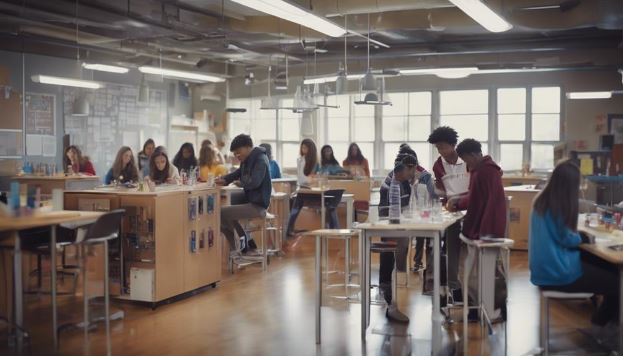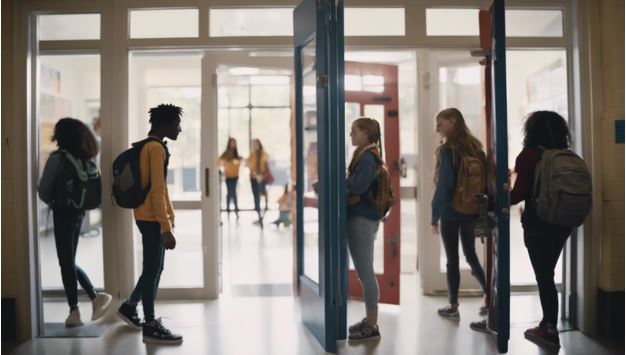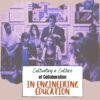Category: High School
Building Community in Virtual High Schools
In response to the challenges of COVID, a dissatisfaction with local in-person schools, and increasingly diverse needs of the high school student population, enrollment in US virtual schools is now over 300,000 with about 20% of students taking at least one online course. There are pros and cons of attending class via computer. You can learn on your own schedule, but what if you have connectivity issues? You have more independence in your learning, but what if the teacher isn’t inspirational?
One big issue among many is the importance of building community in virtual schools. The Ask a Tech Teacher team dug into this:
Building Community in Virtual High Schools
As educators, we often hear concerns about the lack of socialization in online learning environments. However, the reality of virtual high schools is far from the isolated, impersonal experience many imagine. In fact, with intentional effort and innovative approaches, an online high school can foster vibrant, supportive communities that rival those of traditional brick-and-mortar institutions.
The Importance of Community in Education
A sense of belonging enhances student engagement, improves academic performance, and supports mental health. In virtual settings, where students might otherwise feel disconnected, building community becomes even more critical.
Strategies for fostering student connection include: (more…)
Share this:
21 SAT/ACT Prep Online Resources
Here are popular online resources to prepare for ACT and SAT tests (click for updated list):
- Albert Online — lots of SAT practice exams, including subject areas.
- College Board
- Kaplan Test Prep
- Khan Academy reading-writing-practice
- Mindsnacks SAT Vocabulary–a big part of succeeding on the SAT essay is knowing the right word
- Number2.com–for SAT, ACT, GRE
- Perfect Score Project--to prepare for SATs
- Prep Factory–for SATs, ACTs, other
- Quizlet–hundreds of SAT vocabulary prep flashcards
- UWorld SAT Prep
- Veritas Prep–free and fee tips, videos and more
SAT Exams
Here are some that specialize in SAT exams:
Share this:
Harley Wade from State of Writing created 7 Tips for Creating a Budget in High School
It’s graduation time for High School seniors, that moment when they take over their own bills, budgets, and balancing income with outcomes. The Ask a Tech Teacher crew has some great times from Harley Wade on that subject:
Harley Wade from State of Writing created 7 Tips for Creating a Budget in High School
High school is the best time to start learning responsible financial management. If you get a grip on your financial literacy early, you will be able to handle your money more efficiently throughout your life. Financial literacy is defined as the ability to understand how to use financial tools, including personal financial management, budgeting, and investing. The following seven tips by Harley Wade from State of Writing will help high school students learn how to budget properly.
1. Understand Your Income Sources
The first step is figuring out how much money you’re bringing in. What does your parent(s) give you for allowance? How much money do you make from a job or a weekly babysitting or lawn mowing gig? Whenever you have a source of income, it’s good to know exactly how much you’re getting each month. This puts a strict limit on what you have to spend and what you realistically expect to save.
2. List Your Necessary Expenses
A famous Swedish proverb says, “He who buys what he does not need, steals from himself”. To avoid this scenario, list any and all of your regular expenses (phone bill, transportation, school fees, etc), separating wants from needs. Harley Wade from State of Writing suggests that you allocate some funds towards writing services for when you’re too tired or stressed by Googling “Who can write my coursework?”. This will help you find a budget-friendly writing service. Listing all your necessary expenses not only forces you to pay more attention to your priorities, but you’ll also notice where most of your money goes. It also forces you to be prepared for higher-than-normal expenses without your typical budget getting derailed.
3. Set Savings Goals
To get there, it’s essential to set goals about what you will want for yourself down the line. Here’s how you can do it:
4. Allow for Leisure Spending
There is nothing wrong with spending money on things you like! Set aside a portion of your money for entertainment and hobbies. This money can be for movies, games, or eating out with friends. Keeping money for leisure within a certain limit will ensure that you enjoy your money guilt-free rather than feeling like you are wasting it or that you are missing out on something.
5. Track Your Spending
Track everything. Here’s a simple guide on how to track your spending:
- Use a Budgeting App. Install a budgeting app on your phone to log expenses easily. Apps like Mint or YNAB automatically categorize your spending, making it easy to see where your money goes.
- Keep Receipts. Save receipts from purchases and log them weekly into a spreadsheet or notebook. This can help you remember cash transactions or small purchases that add up over time.
- Set Spending Alerts. Many banking apps allow you to set alerts for when you spend money. This can help you stay aware of your spending habits and avoid overspending.
- Review Bank Statements. Regularly check your bank statements to ensure all transactions are correct and to keep track of your spending patterns over time.
- Reflect Weekly. Set aside time each week to review what you’ve spent and compare it to your budget. Adjust your spending as needed to stay on track with your financial goals.
By consistently monitoring where your money goes, you can gain better control over your finances and make more informed decisions about your spending.
6. Review and Adjust Regularly
Plan your budget now, but leave it open for review. Every month, go back and look at your budget and ask yourself: would this budget still work for me right now? Maybe your side hustle gave you a raise. Maybe it wasn’t realistic to budget $25 per week for dinner out with friends. Maybe rent money was more flexible than expected. Regular reviews allow you to tweak your savings and spending to adapt to change.
7. Learn from Mistakes
If you go over your budget, know that you’re not alone – statistics show that over 80% of Americans exceed their monthly budget. We all blow budgets from time to time – maybe we went over our food budget last month because our cousin visited and we felt like treating her, or we didn’t manage to transfer any money into our savings account because we got caught up with something else. Rather than beating yourself up, use these as learning experiences. Work out what you did and why you did it, and try not to do it again in the future. This can make your budgeting skills a lot stronger in the long run.
Building Financial Confidence
Juggling a budget and sticking to it in high school isn’t just about the money, it is also about helping develop the confidence to become more independent. The seven tips will help you fully engage in the present while paving the road to a secure financial future. Budgeting isn’t easy, but you can move towards your financial goals one smart decision at a time.
Author: Philip Richardson
Philip is an article writer and a financial advisor. He loves sharing tips on how people can budget and manage their money. His goal is to help his readers achieve financial literacy.
Here’s the sign-up link if the image above doesn’t work:
Jacqui Murray has been teaching K-18 technology for 30 years. She is the editor/author of over a hundred tech ed resources including a K-12 technology curriculum, K-8 keyboard curriculum, K-8 Digital Citizenship curriculum. She is an adjunct professor in tech ed, Master Teacher, webmaster for four blogs, CSTA presentation reviewer, freelance journalist on tech ed topics, contributor to NEA Today, and author of the tech thrillers, To Hunt a Sub and Twenty-four Days. You can find her resources at Structured Learning.
Share this:
5 Innovative Tech Projects for High Schoolers
Great end-of-year projects for high school students, from the Ask a Tech Teacher team:
5 Innovative Tech Projects for High Schoolers
Project-based learning has gained significant popularity in recent times. Emerging as a creative and insightful way for youngsters to learn and practically implement their knowledge, the idea of project-based learning has been encouraged and applauded by teachers worldwide. In fact, students who make use of this technique tend to retain content 22% better than traditional learning.
Many middle and high schools have started incorporating project work into their curriculum, enabling students to learn concepts faster and apply them to real-world scenarios. However, this shift often perplexes students when choosing the perfect project options. Let’s explore a few options. (more…)
Share this:
12 Innovative Digital Tools to Engage High School Students
High School students will soon move into college and career where digital tools are de rigeur. Knowing the most innovative is a great first step. Here are twelve recommended by the Ask a Tech Teacher team:
12 Innovative Digital Tools to Engage High School Students
In the ever-evolving landscape of education, keeping students engaged can be a challenge. Thankfully, technological advancements have led to the development of digital tools designed specifically to captivate high school student’s attention and enhance their learning experiences.
From virtual reality field trips to interactive quizzing platforms, these 12 tools offer diverse ways to bring lessons to life.
Let’s explore how each tool can transform the classroom environment and spark a love for learning in every student. (more…)
Share this:
The psychology of motivation: Strategies for engaging students
The psychology of motivation: Strategies for engaging students
Motivation plays a role not only in people’s choice to get involved in their goals but also in their behavior, persistence, and, ultimately, success. It is imperative for educators to be aware of the essence of motivation in education in order to create a stimulating environment where students can learn and develop. Through understanding motivation, educators will discover various sophisticated techniques to attract attention and instill a love for learning among students for life.
What does motivation entail?
Motivation is a phenomenon built on the idea of the action of inside and outside factors that together influence an individual to act in the achievement of his/her aims. Experts in psychology have comprehensively analyzed motivation. As a result, they have presented different theories and components which shape the way humans behave. A learner can be driven by two major types of motivation, the extrinsic and intrinsic types, each with its unique characteristics and ramifications on the learning process. (more…)
Share this:
Most Teens Think AI Won’t Hurt Their Mental Health; Teachers Disagree
Generative AI is an exploding influence in education with lots of potential but unknown outcomes. Most people focus on its impact on school research, lesson plans–that sort–but another piece isn’t considered often enough: its impact on student mental health. This next article from but we’ll do in this article from Education Week does
Educators, teens differ on AI’s mental health effects
Teens and educators hold divergent views on its mental health effects of AI, with educators expressing more concern about negative impacts, including cyberbullying and the ability of algorithms to create addictive virtual worlds. Meanwhile, students are more optimistic about AI’s potential benefits.
Full Story: Education Week (3/25) (more…)
Share this:
Engaging All Learners: Expanding High School Options for Success
High School collects a diverse group of students into a large learning community, but it also prepares teenagers for a future as variable as any we can imagine. How is it possible to accomplish that? The Ask a Tech Teacher team has some ideas on balancing varied learning styles with needs to provide students their best chance at success in college or career–whichever they choose:
Engaging All Learners: Expanding High School Options for Success
Think about Albert Einstein, who, despite his genius, struggled in traditional school settings. Today, as education leaders, you’re faced with an increasingly diverse student population, each with unique learning styles, abilities, and aspirations.
Yet, the one-size-fits-all model persists in many high schools. You might be wondering if there’s a better way to engage all learners. Could we expand high school options to guarantee every student’s success?
Let’s explore this, considering some innovative strategies and how they are transforming education as we understand it.
Understanding Different Learning Styles
Your journey to success begins with comprehending the different learning styles and how they impact your educational experience. You see, not everyone assimilates information the same way. Some students are visual learners, digesting information better when they see it in graphs, charts, and pictures. Others are auditory learners, absorbing information more efficiently when they hear it. Still others are kinesthetic learners, who understand better through physical activity or hands-on experience.
Recognizing your learning style isn’t just about understanding how you learn. It’s about maximizing your educational opportunities, tailoring your study habits to your unique style, and ensuring you’re able to absorb and retain information effectively.
You might find you’re not confined to one style. Many people are multimodal learners, integrating two or more styles. By understanding these varying styles, you’re able to adopt a more flexible approach to your education.
Understanding your learning style isn’t just beneficial, it’s crucial. It’s your key to revealing your full potential, optimizing your learning experience, and ensuring your journey to academic success is as efficient and enjoyable as possible.
The Limitations of Traditional High Schools
While understanding your learning style can greatly enhance your educational journey, it’s also worth examining the constraints that traditional high schools may impose on your learning process. These institutions typically adhere to a one-size-fits-all approach, offering a rigid curriculum that doesn’t necessarily cater to the diverse learning needs and styles of all students. You might find that the pace is too fast or too slow for you, or that the teaching methods don’t resonate with your style of learning.
Traditional high schools often prioritize rote learning and standardized testing, which can limit your ability to develop critical thinking and problem-solving skills. They also tend to focus heavily on academic achievement, often neglecting other important facets of education like social skills, emotional intelligence, and practical life skills.
In addition to traditional high schools, online schools in Arizona have emerged as an alternative education option, providing flexibility and personalized learning experiences for students. These virtual institutions offer a range of courses and programs tailored to individual learning styles and needs.
The Rise of Alternative Education Options
In response to these limitations, alternative education options have surged in popularity, offering more flexible and personalized approaches to learning. These alternatives, ranging from charter schools to homeschooling, provide opportunities to cater to individual learning styles and interests that aren’t always met in traditional high school settings.
You’ll find that charter schools, for instance, are publicly funded but independently run, offering unique educational philosophies or specialized curricula. They provide a choice for parents and students dissatisfied with their assigned public schools. Homeschooling, on the other hand, offers the utmost flexibility, allowing learning to be fully individualized and paced to a student’s specific needs.
Online and distance learning programs have also gained traction. These platforms often combine self-paced study with live, interactive instruction, balancing independence with support. Ultimately, vocational and technical education programs equip students with practical skills for direct entry into the workforce.
Keep in mind, however, that while these alternatives can offer flexibility and personalization, they also come with their own challenges. It’s important to weigh the benefits against potential drawbacks to determine the best fit for each learner’s educational journey.
The Role of Technology in Personalized Learning
Building on the trend of diverse educational approaches, we must also consider the significant impact that technology has on personalized learning. As an educator, you’re at the front lines of this digital revolution. Technology, when used correctly, can facilitate tailored instruction that addresses individual learning styles, aptitudes, and pace of learning.
Consider digital platforms that allow you to monitor student progress in real-time. You can identify areas of weakness and strength, adjust lesson plans accordingly, and provide immediate feedback. That’s personalized learning at its best.
Let’s not forget about the wealth of online resources available. Whether it’s an interactive math game or a virtual reality tour of the Colosseum, technology opens up new avenues of learning that were previously inaccessible. This makes education not just personalized, but also engaging and relevant.
However, it’s important to keep in mind that technology isn’t a magic solution. It’s a tool, and it’s only as effective as its use. You must be ready to adapt your teaching strategies, align the use of technology with learning objectives, and ensure equality in access. With careful consideration and planning, technology can indeed revolutionize personalized learning.
Vocational Education: A Viable Pathway
Paving the way for diverse career opportunities, vocational education offers a practical, skills-focused alternative to traditional academic paths. It’s not just about providing another choice; it’s about redefining the meaning of success in education and career planning.
Vocational education, with its emphasis on hands-on training and real-world application, can be a game-changer for you. It’s uniquely designed to bridge the gap between theoretical knowledge and practical skills. This approach can put you on a fast track to a fulfilling career, reducing the time and financial investment often associated with a traditional four-year degree.
Consider these compelling reasons why vocational education deserves your attention:
- It empowers you with job-specific skills, increasing employability.
- It allows for faster entry into the workforce.
- It promotes a learning-by-doing approach, reinforcing understanding.
- It offers a wide variety of career paths to pursue.
- It can lead to higher early-career salaries compared to some traditional degree holders.
Implementing Inclusive Education Policies
Shifting our focus to inclusive education policies, understanding how they’re key to ensuring that every student, regardless of their background or ability, has access to quality education is essential. These policies aim to eliminate all forms of discrimination and promote equal opportunities for all students.
To implement inclusive education policies, you’ll need a thorough approach that encompasses the entire school environment. You’ll need to scrutinize current practices and challenge the existing barriers to inclusion. This involves not only adapting curriculums and teaching strategies but also rethinking attitudes towards diversity and inclusion.
Promoting an inclusive school culture is another important aspect. This means fostering a positive attitude towards diversity, promoting respect for individual differences and ensuring that all students feel valued and included.
In addition, providing adequate training for teachers and school staff is necessary for the successful implementation of inclusive policies. They need to be equipped with the skills, knowledge, and attitudes necessary to respond to the diverse needs of their students.
Case Studies: Successful High School Innovations
Let’s investigate a few case studies that showcase the impact of innovative approaches in high schools, offering powerful insights into the potential for real change in our education system.
One such case is the High Tech High in San Diego. Built on a premise of project-based learning, it has been a significant success, with graduation and college acceptance rates consistently higher than national averages.
Now, consider the following points:
- Personalized Learning: Schools like Summit Public Schools use technology to customize student learning, making education more engaging and effective.
- Learning Through Internship: The Met School in Rhode Island redefines school experience by placing students in internships related to their interests.
- Integrated Studies: New Tech Network schools implement a curriculum that emphasizes real-world connections, fostering deeper understanding.
- Flexible Schedule: Big Picture Learning schools allow students to learn at their own pace, reducing stress and increasing productivity.
- Interdisciplinary Approach: Schools like Quest to Learn integrate subjects to provide a more holistic education.
These examples demonstrate that innovative changes can’t only improve student outcomes, but also transform the very nature of high school education.
Photo Source: https://i.postimg.cc/fW3TccMb/Engaging-All-Learners-Expanding-High-School-Options-for-Success.jpg
Here’s the sign-up link if the image above doesn’t work:
https://forms.aweber.com/form/07/1910174607.htm
“The content presented in this blog are the result of creative imagination and not intended for use, reproduction, or incorporation into any artificial intelligence training or machine learning systems without prior written consent from the author.”
Jacqui Murray has been teaching K-18 technology for 30 years. She is the editor/author of over a hundred tech ed resources including a K-12 technology curriculum, K-8 keyboard curriculum, K-8 Digital Citizenship curriculum. She is an adjunct professor in tech ed, Master Teacher, webmaster for four blogs, CSTA presentation reviewer, freelance journalist on tech ed topics, contributor to NEA Today, and author of the tech thrillers, To Hunt a Sub and Twenty-four Days. You can find her resources at Structured Learning.
Share this:
Cultivating a culture of collaboration in engineering education
National Engineers Week is just behind us. The Ask a Tech Teacher team has one more article discussing an oft-forgotten piece of engineering education: culture:
Cultivating a culture of collaboration in engineering education
The engineering education landscape is shifting because learning is no longer confined to classrooms. Schools and learners recognize that quality education must encompass holistic learning that nurtures academic excellence and cultivates essential life skills. Colleges and universities offering engineering programs are adjusting to the evolution by cultivating a culture of collaboration in education. An inclusive and collaborative environment empowers students to nurture curiosity, continuously improve engineering skills, explore new technologies, and create high-quality engineering solutions. In this post, we’ll explore the value of collaboration in engineering education and top strategies that schools can implement to cultivate a collaborative learning culture.
The case for collaboration in engineering education
Collaboration in engineering education is more than just teamwork; it entails cultivating a mindset that fuels a sense of shared purpose. Creating a culture of collaboration in learning is an indispensable skill in our interconnected world. Here are some of the ways that a collaborative learning culture helps engineering students to learn better and develop personal skills. (more…)
Share this:
Choosing the Right College: Factors to Consider Beyond Rankings
The metrics behind rankings are good to check, but might not accurately reflect what students are looking for. The Ask a Tech Teacher team as suggestions on how to dig deeper, be sure to choose the right college for your needs and future.
Choosing the Right College: Factors to Consider Beyond Rankings
Picking the right college is a huge choice that will affect your life for a long time. It’s easy to let college scores be your only source of information, but they don’t always tell the whole story. In fact, there are many important things besides scores that can have a big impact on your college experience and life afterward. Let’s look into these things, talk about why they’re important, and show you how to use them to help you make a choice.
Understanding the Limitations of Rankings
It’s important to understand why scores shouldn’t be your only concern before we get into the other factors. A lot of the time, college rankings are based on big numbers like graduation rates, teacher credentials, and financial resources. These are important, but they don’t show the little things about each person’s experiences or the important parts of schooling that can make a big difference in your personal and professional growth. (more…)

